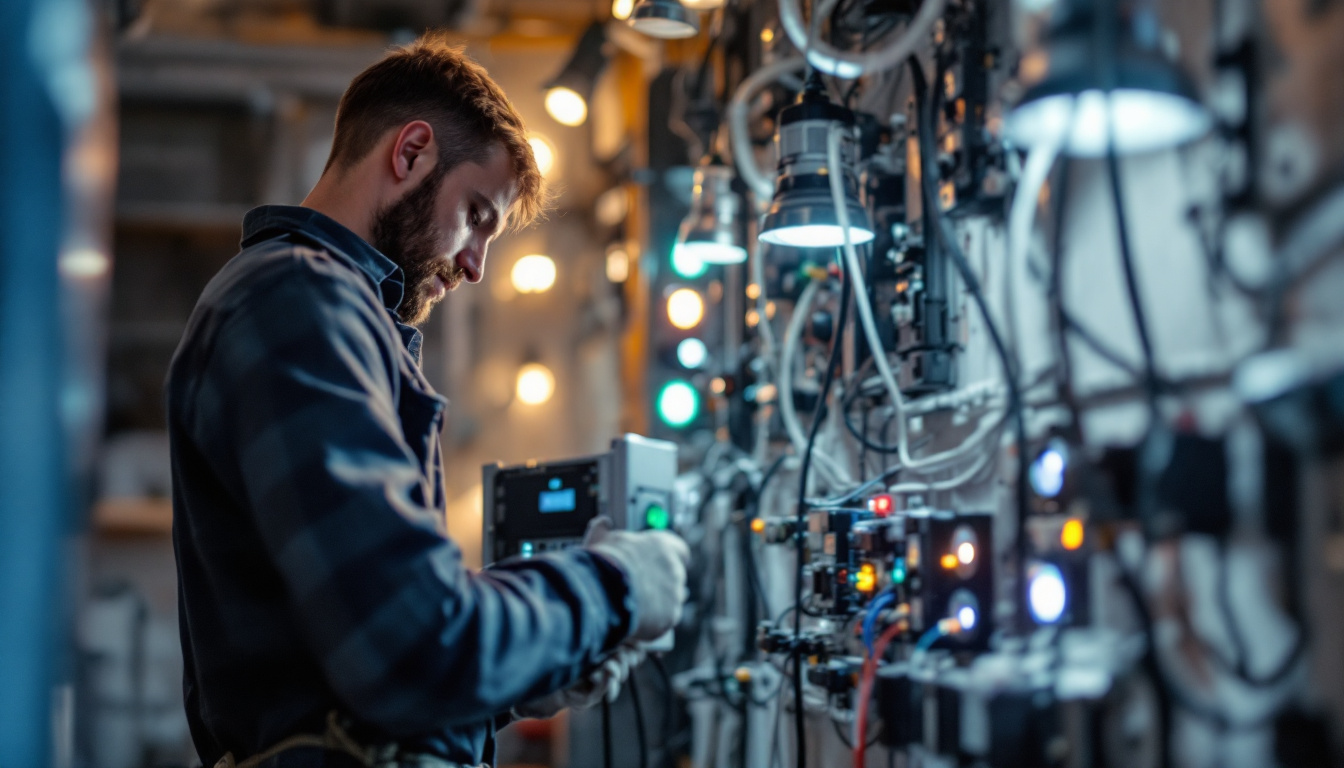
In the world of lighting, the term “ballast” often comes up, particularly in discussions about electrical systems and their implications for lighting contractors. Understanding the role of ballasts in lighting projects is crucial for contractors who want to ensure optimal performance, energy efficiency, and longevity of their installations. This article delves into the significance of ballast electrical systems and how they influence the work of lighting contractors.
Ballasts are electrical devices that regulate the current to fluorescent and HID (high-intensity discharge) lamps. They serve a critical function in starting the lamp and maintaining a steady current during operation. Without a ballast, these types of lights would not function correctly, leading to flickering, reduced efficiency, or even complete failure.
There are two primary types of ballasts: magnetic and electronic. Magnetic ballasts are the traditional option, utilizing electromagnetic coils to control the current. In contrast, electronic ballasts are more modern, offering improved efficiency and performance. Understanding the differences between these types is essential for lighting contractors as it impacts installation choices and project outcomes.
Magnetic ballasts are often heavier and bulkier, making them less convenient for certain installations. They typically consume more energy and can produce a noticeable hum during operation. However, they are often more affordable and can be a suitable option for specific applications. Furthermore, magnetic ballasts are known for their durability and longevity, making them a reliable choice in environments where maintenance access is limited. Their robust design can withstand harsher conditions, which is why they are still favored in some industrial settings.
On the other hand, electronic ballasts are lighter, more compact, and provide better energy efficiency. They can also operate at higher frequencies, which results in flicker-free lighting. This is particularly important in environments where consistent light quality is critical, such as in retail spaces or art galleries. Additionally, electronic ballasts often come equipped with features such as dimming capabilities and programmable settings, allowing for greater flexibility in lighting design. This adaptability makes them an excellent choice for modern architectural applications where aesthetics and functionality must coexist harmoniously. As the push for energy-efficient solutions continues to grow, the transition from magnetic to electronic ballasts is becoming increasingly prevalent, reflecting a broader trend towards sustainability in lighting technology.
Lighting design is not just about aesthetics; it also involves ensuring that the lighting system operates efficiently and effectively. The choice of ballast can significantly influence the overall design and functionality of a lighting project. For lighting contractors, understanding how ballasts fit into the broader design framework is essential.
Energy efficiency is a primary concern for many lighting projects, especially with the increasing focus on sustainability. Electronic ballasts are generally more energy-efficient than their magnetic counterparts, which can lead to lower energy bills and a reduced carbon footprint. For lighting contractors, recommending energy-efficient ballasts can enhance the value of their services and appeal to environmentally conscious clients.
Moreover, many regions offer incentives or rebates for energy-efficient lighting solutions. By incorporating electronic ballasts into their designs, contractors can help clients take advantage of these programs, making the project more cost-effective in the long run. This not only benefits the client financially but also positions the contractor as a knowledgeable advocate for sustainable practices, potentially attracting more business from eco-conscious consumers.
The quality of light produced by a fixture is heavily influenced by the type of ballast used. Electronic ballasts provide a more stable and consistent light output, which is crucial for applications requiring precise color rendering and brightness levels. This is particularly important in settings like photography studios, hospitals, and retail environments where lighting quality can affect the perception of products and spaces.
Additionally, electronic ballasts can reduce flickering and improve the overall visual comfort of a space. For lighting contractors, this means that selecting the right ballast can enhance the end-user experience, leading to greater satisfaction and repeat business. Furthermore, the integration of advanced technologies, such as dimming capabilities and smart controls, can further elevate the functionality of electronic ballasts, allowing for dynamic lighting solutions that adapt to various activities throughout the day.
In environments where mood and ambiance are paramount, such as restaurants and theaters, the ability to manipulate light intensity and color temperature can transform a space entirely. By leveraging the advantages of electronic ballasts, contractors can create tailored lighting experiences that not only meet the practical needs of a space but also enhance its overall aesthetic appeal. This level of customization can set a project apart, showcasing the contractor’s expertise and commitment to quality in lighting design.
While ballasts play a critical role in lighting projects, their installation can present challenges. Lighting contractors must be well-versed in best practices to ensure that ballasts are installed correctly and function as intended.
One of the first considerations when selecting a ballast is ensuring it is properly sized for the lighting fixture. An undersized ballast may lead to inadequate performance, while an oversized ballast can waste energy and create unnecessary heat. Contractors need to consult manufacturer specifications and guidelines to determine the appropriate ballast for each application.
Compatibility is another crucial factor. Not all ballasts are suitable for every type of lamp. For instance, a ballast designed for fluorescent lamps may not work effectively with LED fixtures. Contractors should stay informed about the latest products and technologies to ensure compatibility and optimal performance. This knowledge is especially important as the industry shifts towards more energy-efficient lighting solutions, such as LED technology, which often requires different types of ballasts or even a complete overhaul of existing systems.
Correct wiring is essential for the safe and effective operation of ballasts. Lighting contractors must follow electrical codes and regulations when installing ballasts, ensuring that all connections are secure and properly insulated. Failure to do so can lead to electrical hazards or equipment failure.
Additionally, understanding the electrical load and circuit requirements is vital. Contractors should assess the overall electrical system to ensure it can handle the demands of the lighting installation, including the ballasts. This may involve consulting with an electrician or electrical engineer for larger projects. Moreover, contractors should consider the potential for future upgrades or expansions when planning the electrical layout. By anticipating future needs, they can avoid costly retrofits and ensure that the lighting system remains efficient and effective over time.
Furthermore, it is essential to keep in mind the environmental factors that may affect ballast performance. For example, extreme temperatures or humidity levels can impact the longevity and efficiency of ballasts. Contractors should evaluate the installation site and choose ballasts that are rated for the specific environmental conditions they will face. This proactive approach can significantly reduce maintenance costs and prolong the lifespan of the lighting system, ultimately leading to greater satisfaction for both contractors and clients alike.
Once a lighting system is installed, ongoing maintenance is necessary to ensure its longevity and performance. Ballasts, in particular, may require attention over time, as they can be susceptible to wear and tear.
Recognizing the signs of ballast failure is crucial for lighting contractors. Common indicators include flickering lights, buzzing sounds, or lights that do not turn on at all. Addressing these issues promptly can prevent further damage to the lighting system and maintain the quality of light in the space.
In some cases, replacing a faulty ballast can restore functionality and improve energy efficiency. Contractors should be prepared to diagnose ballast issues and recommend appropriate solutions to their clients.
Implementing regular maintenance practices can extend the life of ballasts and the overall lighting system. This includes periodic inspections to check for signs of wear, ensuring that all connections are secure, and cleaning fixtures to optimize light output. Additionally, contractors should educate clients on the importance of maintaining their lighting systems to ensure ongoing performance and satisfaction.
The lighting industry is continuously evolving, with advancements in technology paving the way for more efficient and effective solutions. As lighting contractors, staying informed about these trends is essential for maintaining a competitive edge.
One of the most exciting developments in ballast technology is the emergence of smart ballast systems. These systems can communicate with building management systems, allowing for greater control over lighting conditions. This can include features such as dimming, scheduling, and remote monitoring, which can enhance energy efficiency and user experience.
For contractors, integrating smart ballast systems into lighting designs can provide added value to clients, offering them advanced control over their lighting environments. As smart technology becomes more prevalent, contractors who are knowledgeable about these systems will be better positioned to meet client needs.
As LED technology continues to dominate the lighting market, understanding how ballasts interact with LED fixtures is essential. Many LED products are designed to work with specific types of ballasts, while others are direct replacements that do not require a ballast at all. Contractors must stay informed about these options to provide the best solutions for their clients.
Moreover, as more manufacturers develop LED-compatible ballasts, lighting contractors will need to evaluate these products to ensure they meet performance and efficiency standards. This ongoing education will be crucial for maintaining the quality and reliability of lighting installations.
In summary, ballasts play a vital role in the functionality and efficiency of lighting systems. For lighting contractors, understanding the various types of ballasts, their impact on energy efficiency and lighting quality, and best practices for installation and maintenance is essential for successful project execution.
As the industry continues to evolve, staying informed about emerging technologies and trends will be crucial for contractors looking to provide the best solutions for their clients. By embracing the importance of ballast electrical systems, lighting contractors can enhance their services, improve project outcomes, and ultimately contribute to a more sustainable and efficient lighting future.
Ready to elevate your lighting projects with the best ballasts and lighting solutions on the market? Look no further than LumenWholesale, where we provide contractors with superior, spec-grade lighting products at unbeatable wholesale prices. Say goodbye to inflated markups and hello to high-performance lighting that meets the highest industry standards. With our hassle-free bulk buying and free shipping, you’ll enjoy premium lighting at the best value — all without hidden fees or compromises. Don’t let your lighting projects be anything less than extraordinary. Wholesale Lighting at the Best Value is just a click away. Experience the LumenWholesale difference today!

Discover the essentials of parabolic lighting in this comprehensive guide tailored for lighting contractors.

Discover the ultimate guide to mastering barn lights exterior with insights from top lighting contractors.

Discover everything shop lighting contractors need to know about 4′ LED shop lights, including compliance tips, benefits, and industry insights to optimize your projects..

Explore how LED lights are revolutionizing the lighting industry, offering energy efficiency and versatility that are transforming the way contractors approach projects.